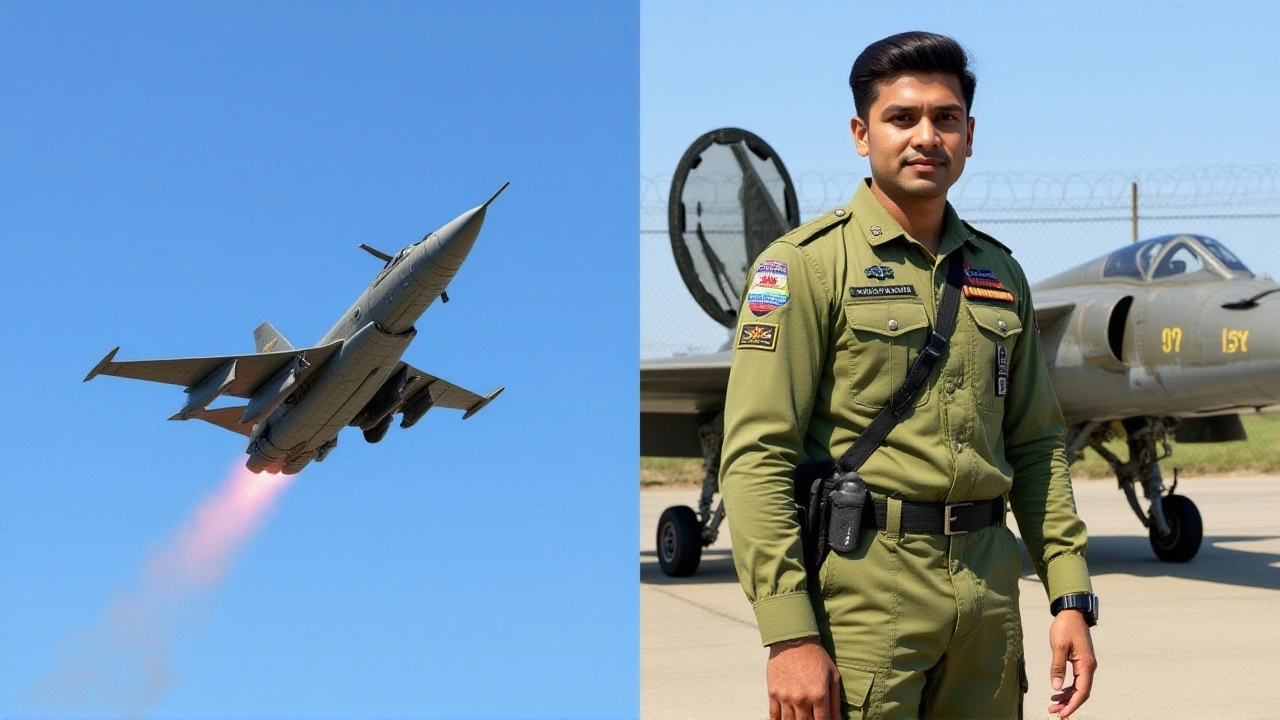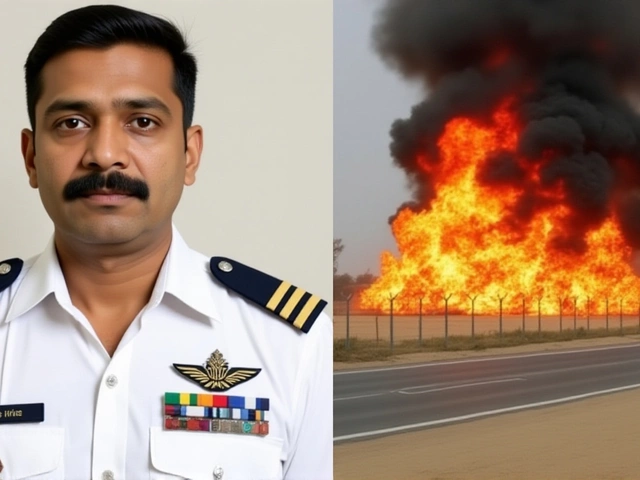Wing Commander Namansh Syal Martyred in Tejas Jet Crash at Dubai Air Show; Final Words to Father Echo Across India

When Wing Commander Namansh Syal took off in the Indian Air Force’s indigenously built Tejas Mk-1 fighter jet at the Dubai Air Show 2023Dubai World Central Airport on November 17, 2023, he was doing more than flying — he was showcasing India’s technological sovereignty to the world. Just hours before the crash, he had spoken to his father in Kangra, Himachal Pradesh, with a quiet pride: “Papa, mere performance ko TV ya YouTube par zaroor dekhiye.” That final request, delivered in the warmth of a son’s love, became a haunting echo when the jet plunged moments later. At 4:00 PM local time, as his father scrolled through live feeds searching for his son’s performance, the video feed cut to smoke, fire, and silence.
A Pilot’s Promise, a Father’s Heartbreak
Wing Commander Syal, 36, was not just any pilot. A decorated officer from the 45 Squadron ‘Flying Daggers’ based in Coimbatore, he had trained for years to fly the Tejas — India’s answer to Western multirole fighters. His family, rooted in a small village in Kangra district, had watched his journey with quiet pride. Neighbors recall how his mother would hang his Air Force photos beside those of Lord Shiva. His father, a retired schoolteacher, kept a printed schedule of the Dubai Air Show pinned to the wall. When Syal called the day before the show, he didn’t ask for blessings. He asked for attention. "Don’t miss it," he’d said. "It’s going to be something." The crash came without warning. Witnesses at the air show described a flawless display — loops, rolls, high-G turns — until the jet entered a tight maneuver at low altitude and suddenly snapped into an uncorrectable spin. Footage circulating online shows Syal smiling beside UAE defense officials just 90 minutes before takeoff, his helmet under his arm, waving with the ease of a man who’d done this a hundred times. He had.
Why This Crash Shook the Nation
The Tejas program has been India’s pride project for over two decades. Developed by the Aeronautical Development Agency and manufactured by HAL, it was meant to replace aging MiG-21s and prove India could build world-class combat aircraft. But until now, it had flown without a fatal accident during public demonstrations. Syal’s death was the first.
The Indian Air Force moved swiftly, announcing a Court of Inquiry within hours. Preliminary reports suggest a possible engine stall during a high-angle-of-attack maneuver — a routine part of the Tejas’s air show routine — followed by a failure in the flight control system’s recovery algorithm. Experts note that the Tejas Mk-1, while reliable, has had earlier issues with its radar and engine performance under extreme conditions. This was not a training flight. It was a global stage. And Syal was its face.
Prime Minister Narendra Modi called it a "tragic loss of a brave son of the soil." Defence Minister Rajnath Singh flew to Coimbatore to personally meet Syal’s wife, Flight Lieutenant Priya Syal — also an IAF pilot — and their six-year-old daughter. In Kangra, the village square fell silent. Children stopped playing. Elders lit diyas. One grandmother, holding a framed photo of Syal in uniform, whispered: "He didn’t die for glory. He died so we could believe we could build something great."
A Legacy Beyond the Sky
The government has announced plans to develop Syal’s ancestral village in Kangra into a national memorial site — complete with a museum dedicated to the Tejas program, a flight simulator for local youth, and a wall engraved with the names of all fallen IAF pilots since 1947. The project, to be funded by the Ministry of Defence and supported by public donations, will be named the Namansh Syal Centre for Aviation Excellence.
Meanwhile, the Indian Air Force has paused all international Tejas demonstrations until the inquiry concludes. But the jet itself? It will fly again. Not because it’s perfect — but because Syal believed in it. His father, in a tearful interview with State Mirror, said: "He didn’t want me to mourn. He wanted me to watch. And now, I will. Every time it flies, I’ll be there."

What Comes Next?
The Court of Inquiry is expected to release its findings in early 2024. If the issue is confirmed as a software glitch or mechanical failure, HAL will be mandated to implement an immediate firmware update across all Tejas Mk-1s. The Indian Air Force may also accelerate the rollout of the upgraded Tejas Mk-1A, which features improved engines and digital fly-by-wire systems.
But beyond hardware, Syal’s death has reignited a quiet national conversation: Who bears the cost of technological ambition? The Tejas wasn’t built in a lab — it was built by thousands of engineers, mechanics, and pilots who poured years into it. Syal was one of them. His final act wasn’t just flying a jet — it was embodying the spirit of a nation learning to stand on its own.
Remembering Namansh
His wife, Flight Lieutenant Priya Syal, has returned to duty, though colleagues say she still wears his flight logbook on her uniform. His daughter, now six, draws pictures of airplanes with the words "Papa’s Jet" scribbled in crayon. In Kangra, a local school has renamed its auditorium after him. And every evening at 4:00 PM, neighbors gather outside his home to watch the sunset — just as his father does — hoping, perhaps, that somewhere above, his son is still flying.
Frequently Asked Questions
What caused the Tejas jet crash at the Dubai Air Show?
The Indian Air Force has launched a formal Court of Inquiry, and preliminary findings suggest a possible engine stall during a high-G aerobatic maneuver, followed by a failure in the flight control system’s recovery protocol. The Tejas Mk-1 has had minor technical issues in the past, but this is the first fatality during an international demonstration. Final results are expected in early 2024.
Who was Wing Commander Namansh Syal?
Wing Commander Namansh Syal, 36, was a decorated pilot in the Indian Air Force’s 45 Squadron ‘Flying Daggers,’ stationed at Sulur Air Force Station in Coimbatore. A native of Kangra district in Himachal Pradesh, he had flown over 1,200 hours, including combat exercises and training missions. He was married to another IAF officer and had a six-year-old daughter.
Why is the Tejas jet significant to India?
The Tejas is India’s first indigenously designed and manufactured multirole fighter jet, developed by the Aeronautical Development Agency and produced by HAL. It represents a major milestone in India’s defense self-reliance, replacing aging Soviet-era MiG-21s. With over 150 units ordered, it’s central to modernizing the Indian Air Force’s fleet.
What’s being done to honor Wing Commander Syal?
The Government of India has announced plans to develop Syal’s hometown in Kangra into the Namansh Syal Centre for Aviation Excellence — featuring a museum, flight simulator for youth, and a memorial wall honoring all fallen IAF pilots. He will be buried with full military honors, and his name will be inscribed on the National War Memorial in New Delhi.
How has the Indian public reacted to his death?
Across India, from Kangra to Coimbatore, people have gathered to pay tribute. Social media has flooded with videos of his final performance, and the phrase "Papa, please watch my performance" has gone viral. Schools, colleges, and even airports have held silent tributes. His story has become a symbol of quiet sacrifice behind India’s technological rise.
Will the Tejas continue to be flown at international air shows?
All international Tejas demonstrations have been paused pending the inquiry’s findings. However, the Indian Air Force has confirmed that the jet will return to air shows once safety protocols are reviewed and upgraded — a decision made not in fear, but in tribute to Syal’s belief in the aircraft and its mission.
